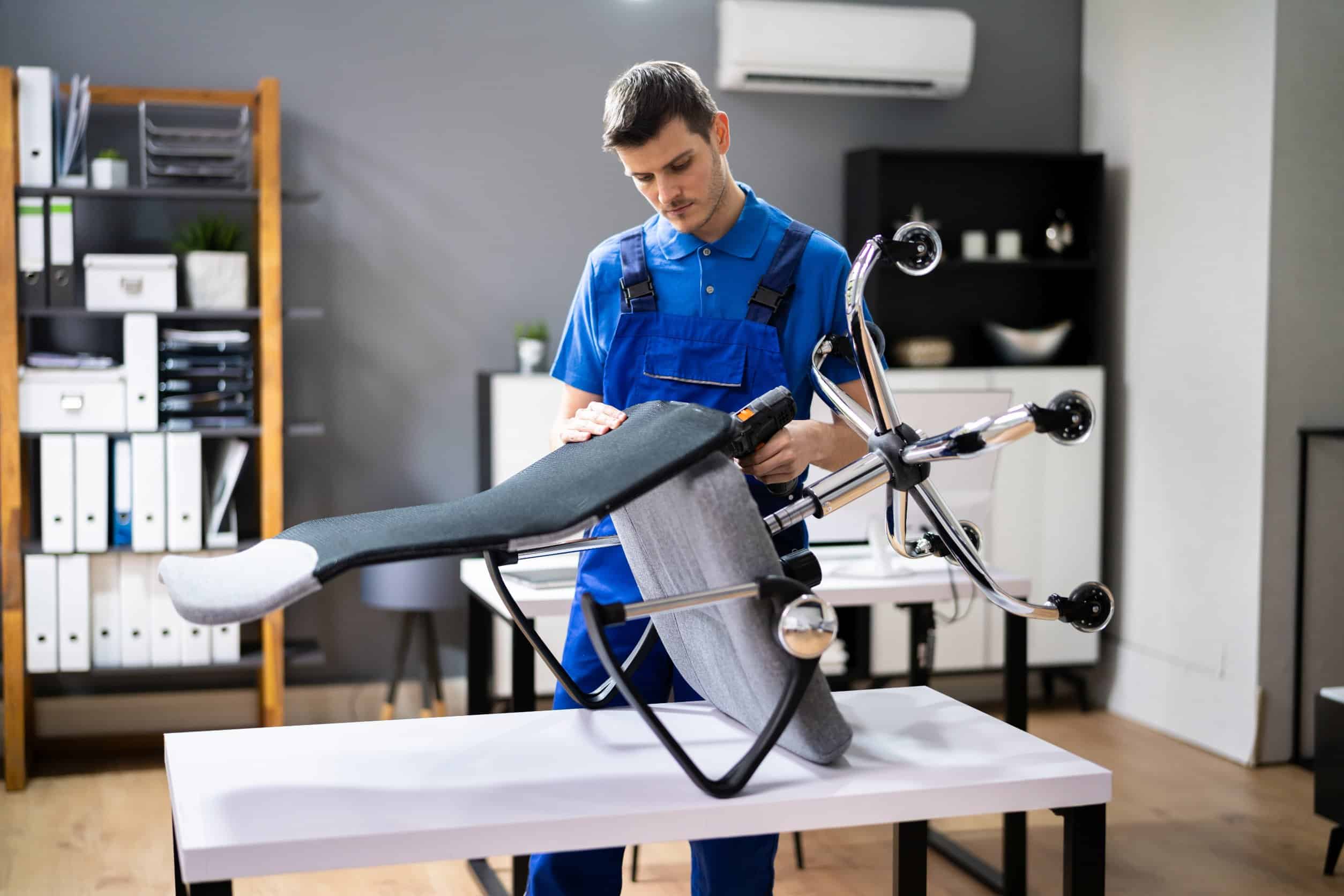Height adjustment is one of the most popular and essential features of any office chair. Setting your chair to the right height can protect you against potential chronic back and neck pain and prevent bad posture, but what if this option is no longer available?
If you’ve never experienced any problems with your chair’s height adjustment contraption, called a “cylinder,” you may take this feature for granted. It’s important to know what to do if your chair starts sinking by itself or if the cylinder stops working. This is why in today’s post, we’ll tell you all about how to fix an office chair that won’t stay up and explain how to set your chair height according to your body height.

How Does a Chair Lift Mechanism Work?
To talk about what’s causing your chair to sink and how to fix it, we should first explain how a chair lift mechanism works.
Mainly, there are two types of chair cylinders: pneumatic and hydraulic lifts.
A pneumatic lift is a mechanism that utilizes pressurized air to lift the chair up. The cylinder features a gas chamber, a valve, and a piston inside. When the chair is lifted all the way up, the mechanism is in a neutral position.
When you apply pressure to the seat with your body weight and pull the height adjustment lever underneath the seat, the valve that seals the air chamber opens up. This allows the piston to compress the air inside the chamber, which causes the chair to lower. When the weight is removed, and the valve is opened up, the air gets decompressed and expands, lifting the chair up.
Hydraulic lifts work in a similar manner, but the source of pressure is different. In a hydraulic lift, a liquid such as machine oil is used to pressurize the chamber inside the contraption.
As you can imagine, when these mechanisms are broken, there’s no way your chair can stay up!
Why Does My Office Chair Keep Sinking?
If your chair keeps sinking and you’re unable to raise it, chances are your chair lift mechanism is broken. There are a few potential culprits, so let’s have a look.
One of the most prominent causes for a gas lift to stop working is a leaky piston. As mentioned above, the whole lift system relies on the pressurized air or liquid inside the chamber to lift the chair up. If the piston has a leak, the air won’t be pressurized.
Similarly, another reason your chair keeps sinking just might be a broken valve that’s on the opposite side of the piston. We’ve explained above that the valve and the piston work together to keep the air pressurized. The release of the valve can lift up the chair, but if it’s broken or stuck, it can’t keep the chair raised.
In short, if the sealed gas or liquid gets a chance to leak, you can say goodbye to your chair’s lifting ability! When this happens, you have a few options, and we’ll now describe all of them in order of ease of application and practicality.
How to Fix a Chair That Won’t Stay Up
There are so many ways to tackle this problem, and while most of them are very easy to apply, they are not exactly permanent fixes. Here, you’ll find all the ways you can stop your chair from sinking when you sit on it, but most of these fixes are temporary. If you’re looking to permanently fix your chair, you’ll need to replace your chair’s cylinder, which we’ll also explain in a bit.
Let’s start with a quick method you can easily apply at home, with items that are easily accessible.
Use Duct Tape and a Hose Clamp
This first method is probably the easiest, and if you have a garden, you might even have the necessary tools already! However, it’s a temporary fix. Your chair will probably start sinking again in a few weeks, so make sure you find a permanent fix by then.
All you’ll need is a hose clamp, also known as a Jubilee clip, and some duct tape. Since the tape is only for preventing the hose clamp from sliding, you can try this method with any kind of tape you may have at home.
Once you get your tools ready, take a look at the cylinder of your chair. You’ll see that it has a telescopic outer plastic casing. Slide it down, and the metal cylinder will be exposed.
Before you do anything with the clamp, make sure to set the chair to the desired height, Since you won’t be able to adjust it afterward. Upon adjusting the height, turn the chair upside down so that you can get to work.
Open the clamp by unscrewing it, and get your duct tape ready. Put duct tape where you’ll place the clamp. This will prevent the clamp from sliding down. Wrap the duct tape around a few times, and try to stick it properly to create a smooth surface. If you don’t have duct tape laying around your house, you can also try scratching the metal surface with sandpaper. The rough surface should create enough friction for the clamp to stay in place.
If you’ve done everything correctly and the clamp is securely in place, your chair should no longer sink. Try it out and see for yourself.
Use a PVC Pipe
This method is similar in principle to the hose clamp method, but it should last for a bit longer.
For this method, you’ll need a PVC pipe that you can cut. You can also use any other material that is strong enough and that you can cut.
Measure the space between the plastic shell and the top of your chair’s cylinder while it’s at your desired height. This will tell you how long of a piece you need to cut. Cut the PVC pipe accordingly, and make sure that the cut is clean and leveled. At this point, you can proceed in two different ways. You can either cut the pipe vertically to put it on the cylinder or take the base of the chair off.
If you choose to cut the pipe vertically, make sure you strengthen it with some duct tape after placing it around the cylinder. If you don’t do this, you’ll have to live with the risk of your chair suddenly dropping at a random time, so make sure it’s completely secure.
If you don’t want to cut the pipe or don’t have duct tape lying around, you can also remove the cylinder to put the pipe on. To do this, you’ll need a rubber mallet and a pipe wrench. Turn your chair upside down and strike the base of your chair with an upward motion. A few strikes should loosen the base right off the cylinder. Next, secure the pipe wrench around the cylinder and use a twisting motion to separate it from the seat. Now you’re free to install the PVC pipe on the cylinder!
Use a Chair Saver Kit
Next up, we have a method that offers much more flexibility as you’ll use a product that’s designed to streamline the whole process.
We’re talking about, of course, Minewill Fix Sinking Office Chair-Chair Saver Kit.... You might also come across these kits under different names, such as “chair saver buddy,” but they work just the same. Essentially, these kits make it so that you don’t have to cut any PVC pipes or fiddle around with a flimsy hose clamp.
Chair saver kits usually include a ring to hold your chair in the desired height setting, and they come with screws and a small screwdriver. It’s a good idea to get a chair saver kit if you don’t have a toolbox at home.
Another clear advantage of using a chair saver kit is that if you’re not satisfied with the height, or if the ring cracks, or breaks, you can install another one! Some kits even come with multiple rings so that you can adjust the height however you like.
If you’re considering buying a chair saver kit, make sure to get ones that include rings that are made of stainless steel or another type of metal. Some kits on the market may look identical at first glance, but the rings might be plastic. These kits don’t last very long and are virtually no different from using a PVC pipe.
Use a Chair Riser
If you don’t want to replace your chair or gas cylinder, another thing you can try is using a Yunnix 4 Pack Black Bed Furniture Risers 3.7 Inch Round.... Chair risers are not exactly exclusive to chairs. In fact, they can be used on a variety of furniture, and they may come in very handy at times.
They are usually extension pieces that you can click or screw on your chair’s legs. However, risers are not the best solution here, as most office chairs have attached casters (wheels). You can try removing the casters before application, but your chair won’t have wheels anymore.
If you’re worried about scratching your room’s wooden floors, you can use wool risers. GorillaRisers CB251-8 Screw on Furniture Risers (8... are usually very thin. You can use them on wooden floors without worrying about any scratches. Some kits may even include both plastic and wool risers that you can stack on top of each other. This helps you reach your desired height while still keeping a smooth surface.
Alternatively, you can look for wooden or plastic chair risers if your floor has a harder, more durable surface. These offer a more drastic height change, and they also provide a more even extension on all sides of your chair compared to a wool riser.
If you want to find out more ways to change the height of your chair, you can check out our guide, where we explain how to raise office chairs.
The Ultimate Fix: Change the Lift Cylinder
This isn’t to say that the above-mentioned methods aren’t great, but they are not really permanent solutions. Besides, they hinder your ability to adjust the height of your chair for good, and that’s certainly not ideal. If you’re looking for a more permanent solution to fix a chair that won’t stay up, you can just change your chair’s lift cylinder.
As we explained, a chair lift has a pressurized chamber inside that is sealed by a valve and a piston. If the valve or the piston is broken or leaking, your chair won’t raise or stay up because the pressure chamber is no longer sealed.
It may sound more complicated than it actually is, but changing your chair cylinder is pretty straightforward. With our detailed instructions, you’ll be able to replace the cylinder in minutes!
How to Change Your Chair’s Lift Cylinder
If you’re pulling the height adjustment lever and nothing’s happening, or if the chair is sinking when you sit down, you’ll need to change this mechanism. The tools you’ll need are:
- A rubber mallet or a hammer,
- A screwdriver,
- A pipe wrench, and
- A new gas lift of hydraulic lift cylinder.
Start by turning your chair upside down to avoid any accidents. Hold the cylinder with one hand while striking the base of the chair with the rubber mallet. You need an upwards motion to loosen and release the base from the cylinder. A hammer works just as fine but will be noisier, and it may also damage your chair base, so be careful.
Once the chair base is removed from the cylinder, it’s time to separate the cylinder from the rest of the chair. Use the pipe wrench to securely and tight hold the cylinder. Once secured, use a twisting motion to loosen the cylinder out of its housing. If the cylinder is not coming off loose easily, you’re going to have to remove the screws.
The screws that hold the cylinder in place are located at the base of the cylinder, where it’s attached to the seat. There should be about 4 of them, but some chairs may include more depending on the model and the design. Once you remove all of these screws using the screwdriver, the cylinder should come right off with ease.
Now you’re ready to install the new cylinder in place, which is the easy part. Follow the directions in reverse, and you should be good to go in a couple of minutes!
How to Set Your Chair to Your Ideal Height
When we spend all day working or studying on a chair, all the environmental factors are working against us. This is why it’s important to set your chair to your ideal height. Using your chair at a fitting height can save you chronic pain and posture problems in the future. Here’s how to do it:
- Start by sitting in an upright position in your chair,
- Bend your knees at a 90-degree angle,
- Keep your feet parallel to the floor, and
- Adjust the height setting until your feet are firmly on the ground.
In addition to this, keeping your chair reclined 10-30 degrees past the right angle (90 degrees) can be the cherry on top of your new ergonomic setting. If you’re looking for a fully ergonomic chair, however, you can check out our guide, where we reviewed the best ergonomic office chairs.
Conclusion
In our guide today, we explained how to fix office chairs that won’t stay up. As we close out, let’s do a recap of everything we’ve covered.
If your office chair is sinking, the culprit is most likely the lift cylinder of your chair. Luckily, there are some easy, at-home fixes you can try before having to change your chair’s lift cylinder. For starters, you can easily fix your problem with a hose clamp and some duct tape. If you don’t have a clamp, a throwaway PVC pipe can also work, and it can be even more durable.
You can also buy a chair saver kit or a chair riser, which can be found online pretty easily. However, keep in mind that none of these methods will let you easily adjust your chair’s height again. To do so, you’ll need to replace your chair’s cylinder. Replacing a cylinder is easy and takes about 10 minutes if you have a rubber mallet or a hammer and a pipe wrench.
Lastly, once you replace your cylinder, make sure to set your chair to a height that’s suitable for your body height. Creating an ergonomic workstation will prevent future back pain, as well as posture-related problems. If you want to learn even more ways to achieve a healthy level of comfort, you can check out our guide, where we explain chair ergonomics in detail.




